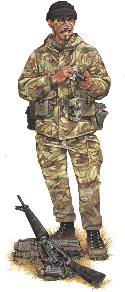 |
The Special Air
Service is a shadowy and secretive regiment
within the British Army. Its unique method of
selection and training, and its operational
role, have ensured in its 55+ year history a
continuity of this 'specialness'. Since 1941
men of the SAS have seen service in over 30
different theatres of war, been in virtually
continuous action, and spawned many foreign
equivalents. The Special Air Service was
born in 1940-41 at the lowest ebb of the war
for Britain. Churchill had called for the
setting up of raiding units able to hit back
against Occupied Europe. By 1940, fledgling
commando and paratroop units had been formed.
In November, 2 Commando was renamed, '11
Special Air Service Battalion' and in
February 1941 'X' Troop from 11 SAS BN. made
the first ever British para-commando raid
against an aqueduct in Italy. It was then
that 11 SAS became the core of the 1st
Parachute Battalion.
Meanwhile, in the Middle East, Colonel
David Stirling had persuaded the C-in-C to
form a small force of para-commandos to wage
irregular warfare behind the enemy lines in
North Africa.
By 1942, the SAS had adopted its badge,
the winged dagger, and been joined by French
and Greek units and a Special Boat Section.
SAS regiments were next committed in
Italy, then in January 1944, the SAS Brigade
was formed with two British and Commonwealth
Regiments - 1 and 2; two French regiments - 3
and 4, A Belgian squadron, 5 SAS, was added
later. Already the Brigade had come a long
way from the original concept of small
raiding parties and was now to be committed
as conventional airborne troops. After D-Day,
however, the old style was revised and the
SAS carried out a series of raids behind
enemy lines, often operating with the
resistance groups.
In October 1945, the British SAS regiments
were disbanded and the French and Belgian
ones absorbed into their own armies. But in
1947, a territorial regiment was raised, 21
SAS, based on the old London volunteer
regiment, The Artists Rifles
It was thought that the SAS were committed
to a role on nay future European battlefield,
but the subsequent SAS story has been one of
fighting in the far-flung conflicts of
colonial withdrawal. In fact, it was during
the Malayan emergency that a special unit
called the 'Malayan Scouts' operated with a
squadron of 21 SAS and from this unit was
spawned the 22 SAS, the regular in today's
army.
From the early '70s, one squadron of the
SAS began to concentrate its training on
specialist anti-terrorist operations, drawing
an ever-tighter veil of secrecy over
operations and methods. The successful
release of hostages at the Iranian Embassy
siege of May 1980 revealed how skilled they
had become and subsequent actions in the
Falklands, Northern Ireland and The Gulf War
have all added to the prestige of what many
people say is the finest special forces unit
in the world.
Today the SAS consists of 22 regiment
based at Stirling Lines in Hereford and 21
and 23 Territorial Regiments. Both regular
and Territorial formations require the same
high standard of recruit. But only 22
Regiment is trained in anti-terrorist
operations and in turn it only recruits from
the Army itself. The headquarters of 22 SAS
controls a training wing, a signals squadron
and a number of so called 'sabre squadrons'.
The Special Air Service deployed two of
these squadrons during the conflict. D and G
squadrons were involved in many special
operations including the capture of South
Georgia, the raid on pebble Island, a raid on
Stanley Harbour, a diversionary raid on Goose
Green and much reconnaissance work. SAS were
also used on the Argentine mainland to report
on the movements of the Argentine Air Force.
|
